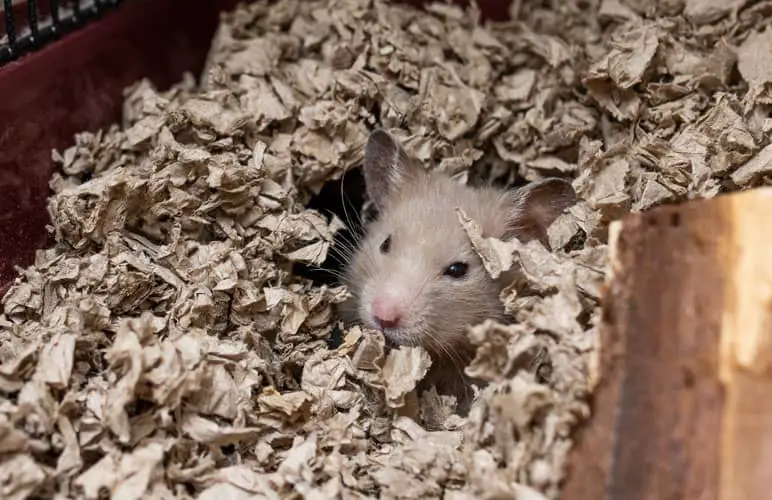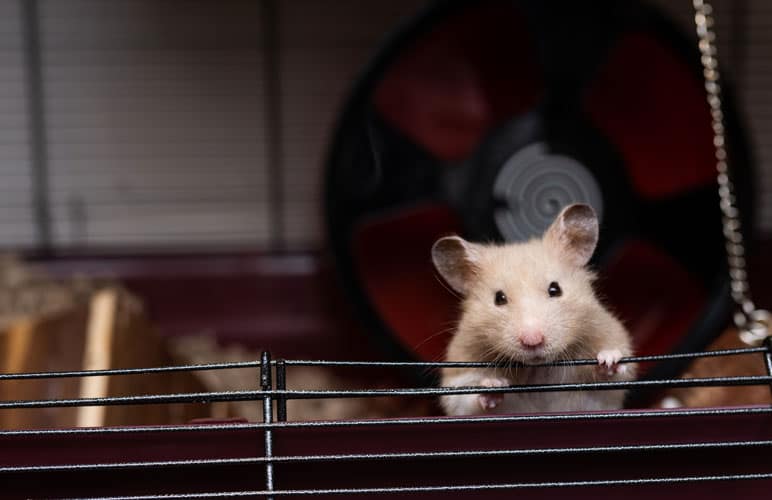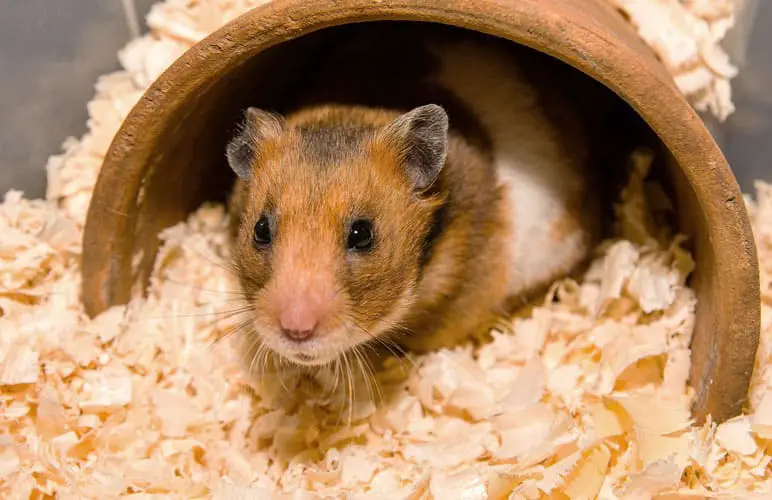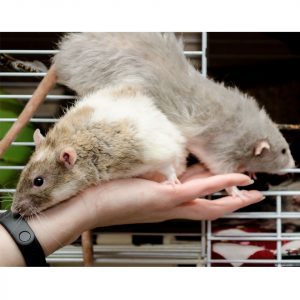Syrian hamsters are known for their love of burrowing and creating nests.
Providing suitable bedding is crucial to meet their natural instincts and ensure their well-being.
In this article, we will explore various bedding options, discuss the setup of a nesting area, and address temperature and humidity considerations for Syrian hamsters.
The Importance of Bedding for Syrian Hamsters
As we said, hamsters are natural burrowers and nest builders. Proper bedding gives them a sense of security, comfort, and the opportunity to exhibit their natural behaviors.
By selecting the right type of bedding, you can create a conducive environment for your hamster’s overall well-being.
Types of Bedding for Syrian Hamsters
There are many different types of bedding that you can add to your Syrian hamster cage!
But which ones are safe?

Aspen Bedding
Aspen bedding is a popular choice among hamster owners. It is made from shredded aspen wood, which is safe for hamsters to burrow in.
Aspen bedding is highly absorbent, controls odor effectively, and is relatively dust-free. Brands like Kaytee Aspen Bedding offer quality options.
Paper-Based Bedding
Paper bedding, made from shredded paper materials, is another safe and widely available option.
It provides a soft and fluffy texture that hamsters enjoy. This type of bedding is suitable for all hamster species and is generally odor-absorbent.
Look for paper bedding brands that are specifically designed for hamsters.
Wood Shavings
Wood shavings, such as pine and cedar, are not recommended for hamster bedding.
These types of bedding may emit strong odors and contain aromatic oils that can harm hamsters’ respiratory systems.
It’s best to avoid them and prioritize safer alternatives, such as Aspen and Paper-Based, as we mentioned before.
Setting Up a Suitable Syrian Hamster Nesting Area
Let’s review what you can do to set up a great hamster nesting area for your Syrian Hamster!
Creating a Cozy and Secure Space
Ensure that your hamster’s cage provides ample room for nesting and burrowing. A nesting area can be created using a hideout or a designated space filled with deep bedding.
This allows your hamster to construct a comfortable nest and feel secure in its environment.
Ideal Bedding Depth for Nesting and Burrowing
Hamsters love to dig and burrow, so providing enough bedding depth is essential. Aim for a minimum bedding depth of around 4-6 inches to allow your hamster to create tunnels and a cozy nesting area.
However, remember that long-haired Syrian hamsters may require shallower bedding to prevent the tangling of their fur.
Influence of Bedding Depth on Behavior
The depth of bedding can significantly impact your hamster’s behavior.
Deep bedding allows them to express natural burrowing instincts, explore, and feel safe in their enclosure. It also provides insulation and comfort.
Observing your hamster’s behavior will help determine the optimal bedding depth that suits their preferences.
Temperature and Humidity Considerations for Syrian Hamsters
Optimal Temperature Range for Hamsters
Maintaining an appropriate temperature is crucial for your hamster’s well-being.
Syrian hamsters prefer temperatures between 65°F and 75°F (18°C to 24°C).
Avoid exposing them to extreme heat or cold, harming their health.
Maintaining Suitable Humidity Levels
Syrian hamsters thrive in environments with moderate humidity. Aim for a humidity level between 40% and 60%.
Excessive humidity can lead to mold growth in the bedding, while low humidity can cause dryness and discomfort.
Monitoring the humidity levels in your hamster’s habitat is important for their overall health.
Bedding to Avoid for Syrian Hamsters
Besides the Wood shavings bedding we mentioned before (which you should NOT use), other types of bedding should also be avoided due to potential health risks for hamsters.
These include dusty bedding that can irritate their respiratory system, as well as bedding made from materials that are toxic or harmful to hamsters.

Here are some bedding options to avoid:
- Dusty Bedding: Avoid using bedding that produces excessive dust particles, which can irritate your hamster’s respiratory system. Dusty bedding can lead to respiratory issues and discomfort for your furry friend.
- Aromatic Bedding: Steer clear of scented or aromatic bedding products. While they may seem pleasant to us, the strong fragrances can be overwhelming for hamsters and may cause respiratory distress.
- Pine and Cedar Bedding: Avoid using pine or cedar bedding for your hamster. These types of bedding contain aromatic oils that can harm their respiratory health. Opt for safer alternatives like aspen bedding or paper-based bedding.
Other Bedding Options and Tips
As you can see, there are quite a few hamster bedding options! But let’s talk about a few more that may interest you.
Compostable Bedding
Compostable bedding is an eco-friendly option that is made from renewable materials. It is biodegradable and can be safely disposed of after use. This type of bedding provides comfort and odor control, making it a great alternative to traditional paper-based bedding.
Fluffy Bedding
Some hamsters enjoy bedding with a fluffy texture. There are specific brands that offer soft and fluffy bedding options, providing extra comfort for your hamster.
Look for bedding made from safe materials like cellulose fibers or soft fabric.
Mixing Bedding Types
You can experiment with mixing different bedding types to create a comfortable and stimulating environment for your hamster.
Combining aspen bedding with paper-based bedding or adding shredded paper as nesting material can provide a diverse and enriching habitat for your pet.
Tip: Bedding Depth Maintenance
Regularly check and maintain the depth of your hamster’s bedding.
As your hamster burrows, some areas may become shallower or compacted. Add fresh bedding to ensure your hamster has enough material to burrow and create its nest.
Choosing the Best Bedding for Your Syrian Hamster
Now that you know all your options, how can you choose the best bedding for your hamster?
Consider Your Hamster’s Preferences
Every hamster has its own preferences when it comes to bedding. Some may enjoy digging and burrowing in deep bedding, while others prefer softer and fluffier options.
Observe your hamster’s behavior and adjust the bedding type accordingly to provide the most suitable and comfortable environment.
Recommendations from Experienced Hamster Owners
Connect with experienced hamster owners or join online hamster communities to gather insights and recommendations on bedding options.
They can share their experiences and provide valuable tips on what works best for different hamster personalities and breeds.
Explore Reputable Bedding Brands
There are several reputable bedding brands available that cater specifically to hamsters’ needs.
Look for brands that prioritize safety, absorbency, and odor control.
Well-known brands include Carefresh, Kaytee Clean & Cozy, and Oxbow Pure Comfort.
Read Product Reviews and Comparisons
Before purchasing a particular bedding product, read customer reviews and comparisons.
This will give you a better understanding of the product’s performance, absorbency, dust levels, and overall satisfaction among hamster owners.
Consider both positive and negative feedback to make an informed decision.
Maintaining a Clean and Healthy Hamster Environment
Before you go, let’s review some quick tips on keeping your hamster environment clean and healthy.

Regular Spot Cleaning
Perform daily spot cleaning of your hamster’s cage by removing any soiled or wet bedding.
This will help maintain cleanliness and prevent odors from accumulating. Be sure to take out any old food.
This is important for a healthy Syrian hamster diet!
Replace the soiled bedding with fresh material to ensure your hamster’s nest remains clean and hygienic.
Cage Deep Cleaning
While spot cleaning is important, it’s also necessary to conduct regular deep cleaning of the entire cage.
This involves removing your hamster from the cage temporarily, disinfecting the cage, and replacing all the bedding.
Don’t forget to use pet-safe cleaning products.
Monitor Bedding for Signs of Contamination or Mold
Regularly inspect the bedding for any signs of contamination or mold growth.
Mold can be harmful to your hamster’s health, so it’s crucial to promptly remove any affected bedding and replace it with fresh material.
Monitor the bedding’s condition closely to ensure a safe and hygienic environment.
Summing It Up
Providing suitable bedding options for your Syrian hamster is essential for their physical and mental well-being.
Aspen bedding, paper-based bedding, and other safe alternatives allow your hamster to burrow, nest, and exhibit their natural behaviors.
Remember to prioritize your hamster’s preferences, maintain cleanliness, and avoid bedding that may pose health risks.
By creating a comfortable and safe environment, you can ensure that your hamster enjoys a cozy nest and a happy, healthy life.




